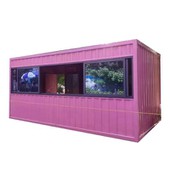Wood Plastic Composites (WPC) is a new type of composite material that has flourished both domestically and internationally in recent years. It refers to the use of polyethylene, polypropylene, and polyvinyl chloride to replace common resin adhesives, and is mixed with more than 50% of waste plant fibers such as wood powder, rice husk, and straw to form new wooden materials. It is then processed through plastic processing processes such as extrusion, molding, and injection molding to produce boards or profiles. Mainly used in industries such as building materials, furniture, logistics and packaging. The board formed by hot extrusion after mixing plastic and wood powder in a certain proportion is called extruded wood plastic composite board.
The foundation of wood-plastic composite materials is high-density polyethylene and wood fibers, which determine that they have certain characteristics of plastic and wood.
1) Good processing performance
Wood-plastic composite materials contain plastic and fibers, therefore, they have processing properties similar to wood. They can be sawn, nailed, and planed, and can be completed using woodworking tools. Moreover, their nail grip is significantly better than other synthetic materials. Mechanical properties are superior to wooden materials. The nail holding force is generally three times that of wood and five times that of particleboard.
2) Good strength performance
Wood-plastic composite materials contain plastic, thus having good elastic modulus. In addition, due to the inclusion of fibers and thorough mixing with plastic, it has physical and mechanical properties such as compression resistance and bending resistance comparable to hardwood, and its durability is significantly better than ordinary wood materials. The surface hardness is high, usually 2-5 times that of wood.
3) It has water and corrosion resistance properties and a long service life
Compared with wood, wood plastic materials and their products are resistant to strong acids and alkalis, water, corrosion, and do not breed bacteria, are less susceptible to insect infestation, and do not grow fungi. Long service life, up to over 50 years.
4) Excellent adjustable performance
Through additives, plastics can undergo polymerization, foaming, curing, modification and other changes, thus changing the density, strength and other characteristics of wood plastic materials, and also meeting the special requirements of anti-aging, anti-static, flame retardant and so on.
5) Has UV light stability and good coloring properties.
6) Its biggest advantage is to turn waste into treasure and can be 100% recycled for reproduction. It can be decomposed without causing "white pollution" and is a truly green and environmentally friendly product.
7) Wide source of raw materials
The main plastic raw materials for producing wood-plastic composite materials are high-density polyethylene or polypropylene. Wood fibers can be wood powder, rice bran, or wood fibers, and a small amount of additives and other processing aids are also required.
8) It can be made into any shape and size as needed.
What is wood-plastic composite material
Jul 25, 2023Leave a message







